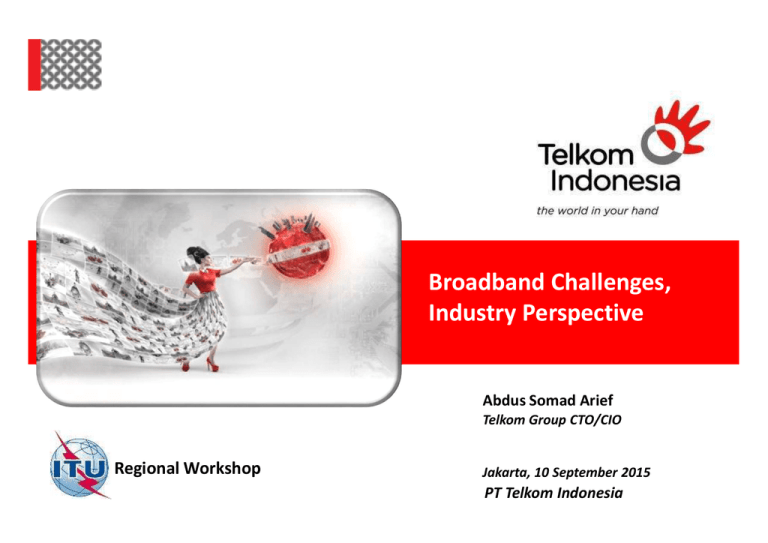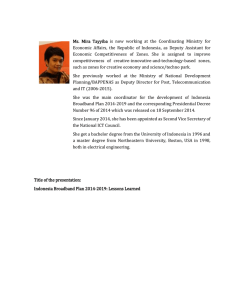Broadband Challenges, Industry Perspective Regional Workshop PT Telkom Indonesia
advertisement

Broadband Challenges, Industry Perspective Abdus Somad Arief Telkom Group CTO/CIO Regional Workshop Jakarta, 10 September 2015 PT Telkom Indonesia Telkom Indonesia at a Glance Telkom Indonesia is listed at Government : 52.6% : 47.4% Public Telkom’s Business Portfolio: TIMES Telecommunication, Information, Media, Edutainment and Services Mobile Multimedia Telkom Indonesia as a holding Business Business company have 4 main subsidiaries: T IME Telkom’s Achievement: Key Indicators (IDR Bn) Revenue Expenses Operating Profit EBITDA Net Income Subscribers (000) Broadband Fixed Broadband Mobile Broadband/Telkomsel Flash Cellular Postpaid Prepaid Total Fixed Line POTS International Business T Infrastructure Business T Telkom’s Price per Share of Common Stock (IDR): EoY 2014 89,696 61,393 29,377 46,508 14,638 EoY 2014 YoY Growth 1H 2015 YoY Growth 8.1% 48,840 12.2% 6.4% 33,717 14.4% 5.5% 15,123 7.5% 6.6% 23,540 6.3% 3.0% 7,447 2.2% YoY Growth 1H 2015 YoY Growth 3,400 31,216 12.8% 80.7% 3,729 33,627 15.9% 84.8% 2,851 137,734 140,585 14.5% 6.8% 6.9% 3,049 141,016 144,065 16.6% 4.6% 4.9% 9,698 3.7% 10,190 7.0% 2012 2013 2014 Feb 2015 High: 3020 Telkom Group’s Highlight: Triple Double Digit Growth International Expansion The First mobile operator to commercially market the 4G LTE in Indonesia 10 International footprints: Singapore, Hongkong, Timor Leste, Australia, Macau, Taiwan, USA, Malaysia, Myanmar, Arab Saudi 2 Telkom Group’s Business Portfolio 16 Business Portfolio: 9 Product Portfolio and 7 Customer Portfolio 10 ME Digital Life Digital Home Digital Advertising 8 9 7 I • Managed Apps & SI • BPM • Premise Integration • E-Payment • DataCenter & Cloud • M2M Platform Services Product Portfolio 4 • Triple Play • Fixed Broadband • WiFi Big Data Ecosystem Solution 5 • Mobile Services • Mobile broadband T Fixed Services Big Data • • • • 1 Mobile Services 2 2 11 E-Health E-Tourism E-Transportation E-Gov 6 • Network Service • Interconnection & International Traffic • Satellite • Tower NW & Infra Services 12 Customer Portfolio Services 1 13 14Government 15 16 3 3 O U T L I N E 1 Global Broadband Facts 2 Indonesia’s Broadband Facts 3 Broadband Roll Out Challenges 4 Global Fixed Broadband Industry The global fixed broadband continues to grow with a total of 711 Million subscribers at the end of 2014 Global Fixed Voice Revenue vs Global Fixed Broadband Revenue Fixed Broadband Subscriber 2014 711 Global Fixed Voice Revenue, CAGR = -4.9% 2014-2020 Million 28% receive speed >= 25 Mbps 2020 814 2.3% CAGR Global Fixed Broadband Revenue, CAGR = 3.1% Million 75% receive speed >= 25 Mbps Source: Ovum Telecoms Proportion by type 2014 19.9% 2020 Cable Modem Fixed broadband subscriptions by country (Millions) 20.2% 1 41.1% 26.9% 2 USA: 98 37.4% 3 Japan: 37 1.3% 4 Germany: 30 FTTx 51.5% China: 200 DSL 1.7% OTHERS* *) Others: Fixed WiMax, Satellite, PLC Source: Broadbandtrends 5 France: 26 Indonesia rank 36th across the world and rank 5th in ASEAN 36 Indonesia: 3 EoY 2014 Source: http://www.itu.int/en/ITU-D/Statistics/Pages/stat/default.aspx 5 Global Mobile Broadband Industry The global mobile industry continues to scale rapidly with a total of 3.6 Billion unique mobile subscriber at the end of 2014 Broadband SMS/MMS Voice Mobile Celullar subscriptions by country (Millions) Source : The Mobile Economy 2015, GSMA 1 China: 1286 2 India: 944 3 Indonesia: 319 4 USA: 317 5 Brazil: 281 Indonesia rank 3rd across the world EoY 2014 Source: http://www.itu.int/en/ITU-D/Statistics/Pages/stat/default.aspx 6 Fixed vs Mobile Broadband Countries with high fixed broadband penetration started to deploy their broadband in 1990s (pre-3G era), where fiber is the only option – they are also very densely populated, making fiber deployments a lot more cost-effective and viable Comparison of different country fix and mobile broadband penetration Pre-3G era (2002) Post-3G era (2013) 57% Brazil China Russia 96% 91% 44% Hong Kong 90% 74% 18% Japan Late broadband adopters 644 69% Korea USA 116% 68% Taiwan Early broadband adopters Population density (/km2) 68% 88% 7% 28% 75% 0% 9% 0% 34 37% 145 53% 1% 32% Fix Broadband Penetration 337 24 14% Indonesia 0% 6,544 37% 13% 0% 512 8 125 Mobile Broadband Penetration Source: Orange Business Service, RPI 2014 – 2019, ITU 2013, World Bank, Nomura, internal analysis 7 O U T L I N E 1 Global Broadband Facts 2 Indonesia’s Broadband Facts 3 Broadband Roll Out Challenges 8 Indonesia Fixed and Mobile Market Revenue Indonesia’s fixed voice revenue experience negative growth but fixed broadband and also mobile voice & non-voice revenue still experience positive growth Mobile voice and non-voice service revenue, and ARPU, Indonesia, 2009–2013 [Source: Analysys Mason, 2014] Fixed retail revenue by service, Indonesia, 2009–2013 [Source: Analysys Mason, 2014] 25 50 120 10.4% 15 10 -8.9% 5 Revenue (IDR trillion) Revenue (IDR trillion) 20 40 35 80 12.7% 60 30 25 3.5% 40 20 15 10 20 ARPU (IDR thousand per month) 45 100 5 0 0 2009 2010 Voice 2011 2012 2013 Broadband 1. Fixed voice penetration of population reached 11.6% in 2013, down from 14.5% in 2009. Fixed voice revenue declined from IDR14.705 trillion (USD1.58 billion) in 2012 to IDR 13.398 trillion (USD1.27 billion) in 2013 at a rate of –8.9%. 2. Fixed broadband population penetration grew from 1.5% in 2012 to 1.9% in 2013. Revenue increased from IDR6.342 trillion (USD0.68 billion) in 2012 to IDR7.000 trillion (USD0.66 billion) in 2013 at a growth rate of 10.4%. 0 2009 2010 Voice revenue 2011 2012 2013 Non-voice revenue ARPU Mobile data growth is flourishing and voice growth is diminishing. The contribution of voice to total mobile revenue declined from 68.3% in 2009 to 54.3% in 2013. 1. Mobile voice revenue increased from IDR54.601 trillion (USD5.9 billion) in 2012 to IDR56.511 trillion (USD5.4 billion) in 2013, at a growth rate of 3.5%. 2. Non-voice revenue increased from IDR42.161 trillion (USD4.53 billion) in 2012 to IDR47.520 trillion (USD4.51 billion), at a growth rate of 12.7%. 9 Indonesia Broadband Plan [Perpres No.96/2014] Strengthen national connectivity through national ICT regulation Investment Plan Total investment 2014 – 2019 = IDR 278 Tn or 0.46% GDP In Billion Rupiah In Billion Rupiah Top 3 IBP Investment Priorities: 1. HR & ICT Industry Dev : 49% 2. e-Government : 31% 3. e-Education : 13% 10 O U T L I N E 1 Global Broadband Facts 2 Indonesia’s Broadband Facts 3 Broadband Roll Out Challenges 11 Business Challenges: High Cost versus Low Price Mobile data price in Indonesia cannot compensate its mobile data cost Mobile data cost in Indonesia $30 / 500 MB or $ 0.6 cent / MB Mobile data price in Indonesia $15 / 500 MB Source : Asley Feinberg, http://gizmodo.com/the-price-of-500mb-of-mobiledata-across-the-world-1442047579 Initiative: 1. New technology (Heterogeneous Network, NFV/SDN) 2. Selected infrastructure sharing 12 Business Challenges: Spectrum Scarcity Spectrum is limited resources, allocation and utilization should be efficient and effective Indonesia is experiencing ‘scarcity’ of spectrum: 16 MHz in 2013 and estimated 157 MHz in 2016 Source: Indonesia Broadband Plan Source : Company Info Memo, Company Annual Report, BRTI, Internal Analysis 13 Business Challenges: Revenue Declining Almost all largest global telco operators experience negative annual trends on their revenue, assets, and net income. Business model & market readiness becoming significant challenges. China Mobile Telstra AT&T Verizon Bharti Airtel Singtel SK Telecom Vodafone Source: Forbes, http://www.forbes.com/sites/liyanchen/2015/06/01/the-worlds-largest-telecom-companies-china-mobile-beats-verizon-att-again/ 14 Business Challenges: Digital Services as New Revenue Driver NTT Docomo’s voice revenue proportion only 21% while data and “Smart Life” services revenue takes much bigger portion and it compensated declining of voice revenue and voice ARPU DOCOMO’s Revenue Trend DOCOMO’s ARPU Trend NTT Docomo is striving to serve customer as a “Smart Life Partner” with expanding Digital Commerce Business through “dmarket” and various “Smart Life” services 3000 3rd party content providers & 20 Million monthly users in March 2016 Beyond dmarket, Docomo has also deployed other value added services including navigation, local information, NFCbased wallet and information services, credit card and carrier-billing-based payments, translation apps, health and wellness services, insurance, pet and child tracking RESULT Billions of Yen Revenues from Docomo Smart Life businesses, which provide consumers with advice, information, security, cloud storage and other lifestyle services, grew 22 percent to 437 billion yen (US$3.5 billion) in the FY2014. Source: https://www.nttdocomo.co.jp ; http://ipcarrier.blogspot.com/2015/07/ntt-docomo-earns-15-of-revenue-from-non.html 15 Business Challenges: Indonesia Telco Initiative Building Indonesia Digital Ecosystem through andIntegrated Device-Network-Application Digital Business The Facilities : • • • • • • • • - Area : 1200 M2 - Capacity : 20 Startups - Established : 2014 - Area : 1200 M2 - Capacity : 20 Startups - Established : Dec 2011 1,000++ square meters Creative Rooms (10-20) Co-working space Lounge & Café Meeting Rooms Servers & Multi-platform Gadgets 24/7 Operation High Speed Internet - Area : 1000 M2 - Capacity : 10 Startups - Established : August 2013 16 Coverage Challenges: Broadband Backbone Readiness Telkom’s FO backbone has been deployed 76.700 Km from Aceh to Papua, also in progress the Indonesia Global Gateway and the launch of Satellite Telkom-3S (2016), Satellite Telkom-4 (2018) 17 Coverage Challenges: Nationwide Coverage Indonesia government’s USO initiative to expand broadband coverage Government’s USO initiative: To roll out broadband backbone connecting all Kabupaten all over Indonesia USO Expense (IDR Bn) 1,216 1,083 961 479 Telkomsel Merah Putih Telkomsel invests funds to build broadband in the Rural Areas. Power utility and transmission becoming significant challenges. 125 - 17 11 2006 2007 2008 2009 2010 2011 2013 2014 1. Maritime services : BTS in the PELNI’s ship to provide special cellular services. Total 16 BTS since 2009. 2. Rural Industry/ Corporate Services : BTS Rural Corporate: 37 Sites, Femto Offshore: 84 sites. 3. Rural Residential Area : BTS Rural Village, special cellular services for potential villages in the isolated area. Telkomsel provide 186 Sites in Rural Village. *) 2012: no data Source: Mastel &BP3TI 18 Thank
